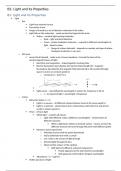Class notes
Chemistry for Biology Students (CHEM0010) Notes - Spectroscopy
- Course
- Institution
Explore Chemistry for Biology Students with these specialized notes tailored for Year 1 students at University College London. Immerse yourself in the fascinating world of spectroscopy, where discussions unfold on the properties of light, UV-visible light, and the principles of infrared and NMR spe...
[Show more]



